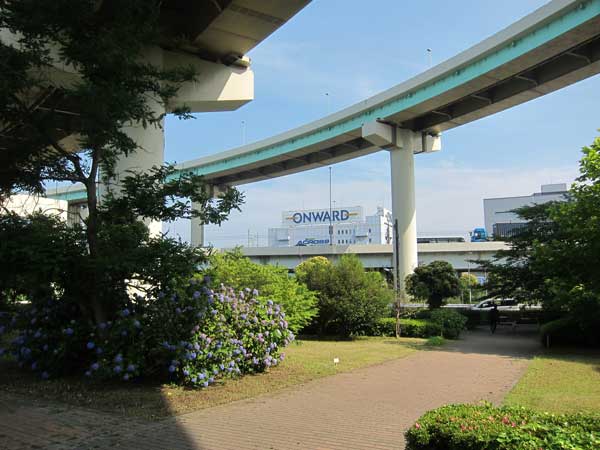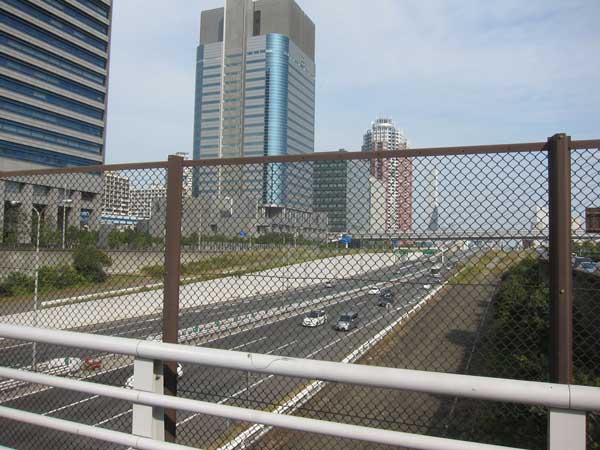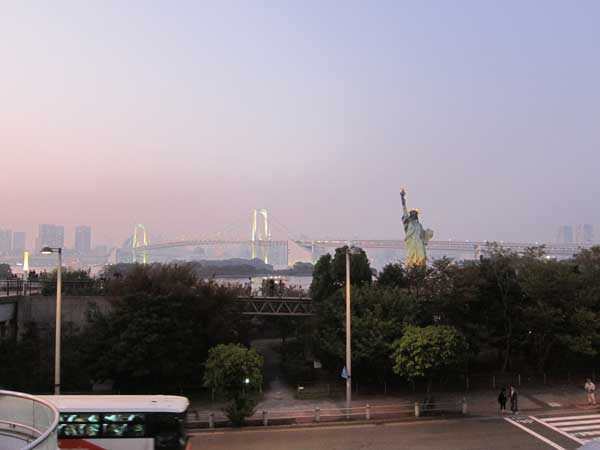
It’s about 10 am, about 24 hours into the boat trip, when I notice this worker uncoupling the containers. We must be arriving in port soon. Behind the worker and the containers, that’s a lot of ocean!

オランダから来た建築家や都市研究者による「成長後都市の生活」についてのワークショップのために、最近、浜離宮庭園に行きました。江戸時代とモダンが混ざっています。
Recently I brought 28 participants of the Dutch-Tokyo Still City workshop on “post-growth” urban life to Hamarikyu garden. This photo captures the simultaneity of activities inside and outside the garden: Edo-style pruning of pine trees, city dwellers enjoying traditional tea, port and luxury housing structures, even an incinerator chimney.

千葉の御宿に着くと、きれいなヤシの並木が見えます。細くて背が高いです。カリフォルニアに人気なメキシコのヤシみたいです。急行で行くと、東京から御宿は近いです。電車からの東京湾の景色が大好きです。
I love how this row of skinny palm trees greets visitors to Onjuku, Chiba right from the station. They look like Mexican fan palms (washingtonia robusta) which are very common in California.
Onjuku is an 80 minute ride on the express train, and the beach is a 10 minute walk away. It’s great to visit the beach even for an afternoon. The trip by train is also fun. I love to see the port buildings and activities.



Leaving the Tatsumi Metro station, I cross over one highway on a pedestrian bridge, while passing below several elevated highways intersecting with flyovers.
This Onward sign on top of a warehouse feels like a personal extortion to move through this jumble of smog and burning fuels. Onward also seems to capture this part of Tokyo’s role as a place of distribution by ship and tractor trailer. In this frenzy of “logistics,” I always wonder what’s being transported and to whom.
Fortunately, the trees planted decades ago muffle the noise somewhat, and part of this marginal land is used as a park, community vegetable garden, and Olympic level swimming pool.

お台場の駅から浜に行く途中で、この大きな高速道路を渡らなければなりません。空いた所有地のほうが開発されたものより多いです。だから、出入り口のふたつが放棄されて、そこに植物が育っています。浜からの景色は楽しいです。港やスカイラインやレインボーブリッジや小型の自由の女神が見えます。この組み合わせはちょっと奇妙です。
Exiting the subway station in Odaiba, the way to the famed “beach” with city view includes walking past vast parking lots and then over this eight lane freeway.
What’s amazing about this view is that in addition to the enormous freeway, there are abandoned ramps on both sides, that are gradually being reclaimed by plants. Is land so value-less that this waste is considered appropriate?
There are still more empty than developed parcels on Odaiba, an urban development project with mixed results. The focus on freeways, parking lots, and chain restaurants and stores often makes it feel like a generic exurban landscape.
I hear that it is a popular place for dates. But I’ve been there only three times in as many years. Most recently I was there to get a ride to Umi no Mori for a volunteer tree planting day (more on that later). But a few extra hours gave me my first taste of Odaiba itself.
Once across the freeway and past the mall, there are some beautiful public spaces including an artificial beach. There are views of the port, the Tokyo skyline with the Rainbow Bridge, and some odd built decor that includes a mini Statue of Liberty on land.

